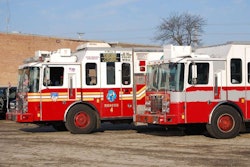… In heavy-duty truck parts and equipment distribution.
(This is part one Bill Wade’s two-part educational feature on service. Be sure to check www.truckpartsandservice.com again Friday for part two of the article.)
For distributors, especially those in the heavy-duty truck parts business, service is a vital source of revenue, customer satisfaction and competitive differentiation. Finally, heavy-duty truck parts distributors are recognizing the value of becoming service-led organizations and are re-aligning their service operations with their overall business strategies.
Heavy-duty distributor managers are looking to new customers for growth. Surprisingly, an increasing proportion of the general managers I’ve recently contacted view new customers as their most important source of revenue growth.
This is a very surprising and non-traditional direction, since driving new business traditionally falls behind growing with current customers and increasing penetration by the distributors.
According to research from The Loyalty Effect, repeat customers spend, on average, 67 percent more than new customers. It can cost 5 to 10 times more to acquire a new customer than retain an existing one; and 20 percent of customers account for 80 percent of total revenues.
Also, 1 to 5 percent of “elite” customers account for up to 40 percent or more of a company’s revenue mix. Yet very few companies even know who their top customers are, let alone treat them differently. (Contact the author about WayPoint Analytics to address this problem).
Placing equal importance on opening new accounts with generating revenue from the existing customer base could be a reflection of the current economic cycle. When customers are growing, it is easy to grow with them. When customers are struggling with business uncertainties and increasing costs of fuel, logistics and employee benefits, growth becomes difficult for everyone.
Getting the Whole Organization Involved
Increasing the role of service technicians in the sales process is a growth strategy that is gaining momentum. The importance of empowering service engineers with information to allow them to cross-sell and up-sell in the field is reaching a new peak.
Information technology, especially featuring mobile access, removes growth barriers by helping managers to monitor the supply chain more effectively and improve sales tracking capabilities in order to win new customers.
New Service Strategies
Aligning service initiatives with product distribution strategy is becoming core to heavy duty success. The top three strategies are:
• Increasing the proportion of service revenue in the service/product mix, including increasing PM services, growing the sales role of technicians and increasing fee-for-diagnostics;
• Increasing revenue from preventive maintenance;
• Using information technology to help analyze the common needs of customers.
An often cited strategy for revenue growth can be summarized as, “Taking the services we have and selling them aggressively.”
Several distributors reported they are hoping to increase revenue from services they already offer rather than expanding new services or packaging them in customer dictated bundles. In this scenario, opening new accounts takes on a new urgency.
Adding new services as a price-fighting alternative should be carefully considered. Fleet supply differentiation can center on carefully designed service menu additions and alterations, with an analysis of levels of service being the key planning component:
• Bench Service: Especially hydraulics, driveline, u-bolt bending, friction (clutch or brake) and other machine shop specialties.
• 40 / 80 / 120 Shop Hours: Weekly schedule may be determined by available workforce as much as by customer preference.
• 24-7 and Weekend Hours: Great for overhead absorption, but may not be in demand in certain areas.
• Mobile / Tow-Recovery: Mobile service is a domiciled fleet favorite, but tow/recovery may be better suited for a partnership with existing specialists.
• On-Vehicle Service: This is ‘big boy territory,’ since getting in to this could easily be a $1 million/bay investment.
An important growth tactic here is increasing the role of service technicians in the sales process. Service technicians are the eyes and ears of the marketplace, yet increasing their sales role has become a lost opportunity for decades.
Involving service technicians in the ‘sales’ effort is a concept that is being implemented more frequently. Increasing their sales roles will sometimes feel like “squeezing a square peg into a round hole.” However, the most effective business-to-business sales people are usually the people who customers see as the most insightful and effective problem-solving partners.
Analysis of services used in the field and how they are ‘naturally packaged’ will help keep service technicians in a comfortable environment as they learn the skills required to both solve customer problems and grow sales revenues. Making the “paperwork” of sales easy and immediate for field-service technicians will pay off quickly.
Bill Wade is a partner at Wade & Partners and a heavy-duty aftermarket veteran. He is the author of Aftermarket Innovations. He can be reached at [email protected].










